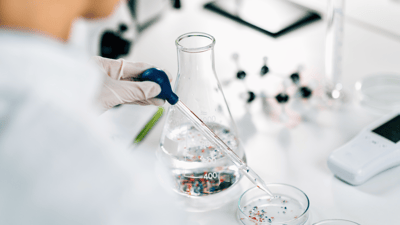The average person drinks about half a gallon of water a day. Combine that with other water consumption (showers, faucet uses, washing machine), most people average 85 gallons of water-use a day. That's a lot of water! And for the majority of Americans, that water has been gathered, treated, and dispersed by a public water system.
More than 90 percent of Americans get their tap water from public water utilities. So if you're part of that percentile, you've probably asked the question: how clean is my drinking water?
What is water quality?
Water quality is a measure of the suitability of water, based on physical, chemical, and biological characteristics. Those characteristics can depend on the water's source and the treatment it receives.
Why is water quality important? According to the National Water Quality Month website, "having high quality, unpolluted water is constantly taken for granted, especially by developed countries...what most Americans don't realize is that not all water is created equal and having immediate access to clean water is a privilege, not a right."
It's easy to assume we should have access to vast amounts of water, especially when you consider that water makes up 70 percent of the Earth's surface area. However, only about three percent of that water is freshwater, and only one percent is easily accessible.
Common Sources Of Contamination
According to the Center for Disease Control and Prevention, the United States has one of the safest water supplies in the world. Despite this fact, water can still be subject to contamination. So what often causes the contamination?
1. Industry and agriculture
Petroleum products and metals used in the oil and gas industry can seep in aquifers, contaminating the water. And pesticides and fertilizers from farming can be carried into lakes and rivers or also seep into aquifers.
2. Human and animal waste
Waste from sewage tanks can also carry harmful microbes and bacteria into water sources.
"Without regular maintenance, public infrastructure like our sewage systems fall into states of disrepair, letting untreated or inadequately treated municipal sewage leak into our groundwater and surface water..." according to the National Water Quality Month's website.
Some of the major contaminants from waste include E. coli, Cryptosporidium, and Giardia.
3. Natural sources
One of the most common contaminants in drinking water is arsenic, which naturally occurs in rocks and soil. Some groundwater is contaminated simply from the underground conditions it travels through.
4. Treatment and distribution
While many of the chemicals used in the treatment process help remove contaminants, they can also remain in the finished product and may be harmful. Water can also become contaminated from corrosion or breaches in the piping system.
 Water Treatment Process
Water Treatment Process
According to the CDC, public water systems can use different water treatment methods to provide and distribute safe drinking water to their communities. However, the most common treatment steps are listed below.
1. Coagulation and Flocculation
During the water treatment process, chemicals with a positive charge are added to the water. That positive charge neutralizes the negative charge of dirt and other dissolved particles. When this occurs. the chemicals bond with negative-charged particles and become larger. These large, bonded particles are call floc.
 2. Sedimentation
2. Sedimentation
Those heavy floc particles settle to the bottom of the processing tank during the sedimentation process, leaving the clear water at the top.
3. Filtration
That clear water is passed through filters (made of sand, gravel, charcoal, etc.) to remove any other dissolved particles. The filtration process helps remove dust, bacteria, parasites, viruses, and any chemicals used already during the process.
4. Disinfection
Once the clear water has been filtered, a disinfectant may be added. Chlorine is the most common disinfectant used to kill any remaining contaminants. The disinfectant also helps protect the water as it moves through pipes to homes and businesses.
5. Water Fluoridation
Fluoride is a chemical that naturally occurs in most water supplies and minerals. Since 1945, most public water systems have been enhancing the fluoride in water supplies to provide residents with the benefits of fluoride which include cavity prevention and enamel support. That's right, when you drink tap water, you're helping out your teeth!
While treatments may vary, all public water systems are held to certain standards and regulations. The United States Environmental Protection Agency sets contamination standards all public water systems must meet, and continuously monitor water utilities to ensure those standards are being met.
Water Quality Standards
The Safe Drinking Water Act
The Safe Water Drinking Act was passed by Congress in 1974 with the goal of protecting the public's health by regulating water supply. The SWDA sets standards and requirements for water treatment and sets a maximum contaminant level. Under the SWDA, the EPA monitors and ensures state and local water authorities are meeting the standard.
National Primary Drinking Water Regulations
The National Primary Drinking Water Regulations are also set by the EPA and "are standards and treatment techniques that public water systems must follow. These regulations protect public health by limiting contaminants in drinking water." The EPA's website provides a list of those contaminants, their sources, and the effects they may have after long-term exposure.
National Secondary Drinking Water Regulations
The National Secondary Drinking Water Regulations are guidelines for public water systems to help them manage their drinking water for issues not related to health. These include taste, color, and smell. The NSDWR provides a list of contaminants that may not be harmful, but may cause water to look cloudy, or taste and smell bad. However, public water systems are not required to follow these regulations.
These standards and treatments help ensure this precious resource is best treated for human health and consumption. Available technologies such as SitePro can also maximize water quality, helping water utilities safely treat, store, and distribute water to its population. For more information on how to enhance your water treatment process, click the button below.
